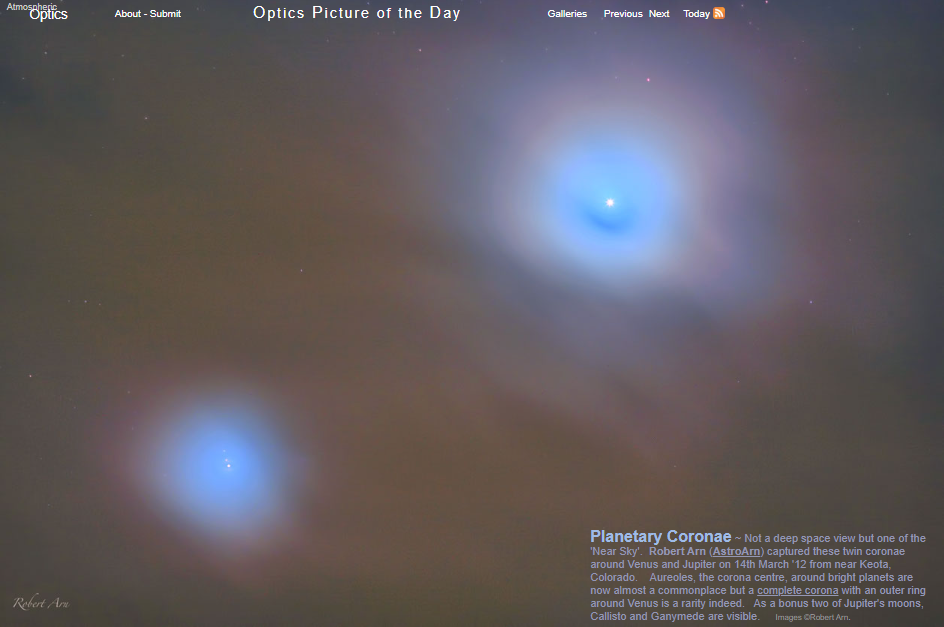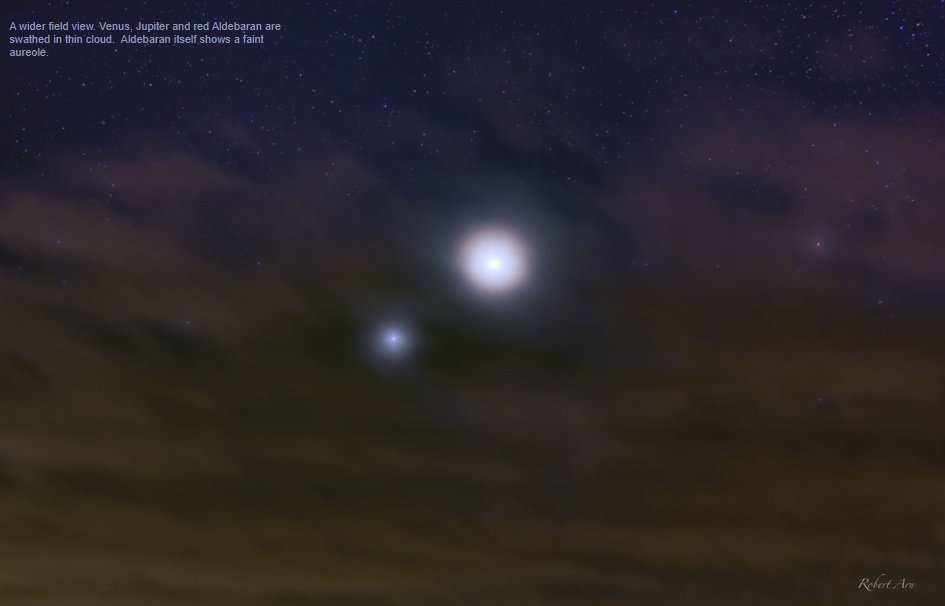OPOD - Planetary Coronae
OPOD - Planetary Coronae: A Rare and Spectacular Atmospheric Phenomenon
Have you ever looked up at the sky and been captivated by the celestial beauty that unfolds before your eyes? One such breathtaking phenomenon is the occurrence of planetary coronae. While we often associate coronae with deep space views, they can also be observed in the 'Near Sky'. On March 14th, 2012, astrophotographer Robert Arn (AstroArn) captured a stunning image of twin coronae around Venus and Jupiter from near Keota, Colorado. These images provide a glimpse into the rare and captivating world of planetary coronae.
Unveiling the Beauty of Planetary Coronae
Aureoles, which are the corona centers, surrounding bright planets have become quite commonplace in the world of astronomy. However, witnessing a complete corona with an outer ring around Venus is a rarity indeed. In Arn's image, we are treated to the sight of not only these remarkable coronae but also the presence of two of Jupiter's moons, Callisto and Ganymede. It's a celestial spectacle that leaves us in awe of the wonders of our universe.
Exploring the Image in Detail
Let's delve deeper into the technical aspects of these stunning images. Arn used a Canon XSi camera (modified) with a Canon 200mm f/2.8L lens mounted on an Astrotrac for the close-up shot. The exposure settings for this shot were 1x30, 1x60, and 1x120 seconds at f/4 ISO 400. The resulting high dynamic range (HDR) image beautifully captures the intricate details of the coronae.
For the wider field view, Arn used the same Canon XSi camera (modified) but with a Canon 50mm f/1.4 lens mounted on an Astrotrac. This shot was a single exposure of 1x120 seconds at f/2.8 ISO 400. The composition includes not only Venus and Jupiter but also the red star Aldebaran, which is enveloped in a faint aureole.
The Rarity of Planetary Coronae
Planetary coronae are not commonly observed phenomena. They occur when light from a bright celestial object, such as a planet or star, interacts with tiny water droplets or ice crystals in the Earth's atmosphere. This interaction causes the light to scatter and create a luminous ring or aureole around the celestial object.
The presence of a complete corona with an outer ring around Venus is particularly rare. This occurrence suggests that the atmospheric conditions were just right for the formation of such a spectacle. It is moments like these that remind us of the ever-changing and mesmerizing nature of our planet and the universe beyond.
The Science Behind Planetary Coronae
To understand the science behind planetary coronae, we need to explore the phenomenon of atmospheric optics. Atmospheric optics deals with the study of how light interacts with particles in the Earth's atmosphere, leading to various optical phenomena. These phenomena include rainbows, halos, and, of course, coronae.
In the case of planetary coronae, the light from a celestial object passes through the Earth's atmosphere, encountering tiny water droplets or ice crystals. These particles act as prisms, bending and scattering the light in different directions. The scattered light then reaches our eyes, creating the mesmerizing display of a corona.
Capturing the Beauty of Planetary Coronae
Photographing planetary coronae can be a challenging yet rewarding endeavor. To capture the intricate details of these atmospheric phenomena, astrophotographers often rely on specialized equipment and techniques. The use of long exposure times and high dynamic range imaging can help bring out the subtle colors and intricate patterns present in coronae.
Additionally, choosing the right location and timing is crucial. Atmospheric conditions, such as the presence of thin clouds or haze, can enhance or diminish the visibility of coronae. Patience and a keen eye for detail are essential for astrophotographers hoping to capture these elusive celestial displays.
A Glimpse into the Near Sky
Planetary coronae provide us with a glimpse into the captivating world of atmospheric optics. These celestial displays remind us of the ever-changing nature of our planet's atmosphere and the wonders that await us just beyond our reach. From the rare occurrence of a complete corona with an outer ring around Venus to the presence of Jupiter's moons, these images by Robert Arn transport us to a realm of beauty and mystery.
As we continue to explore and study the phenomena occurring in our atmosphere and beyond, we gain a deeper understanding of the intricate mechanisms that shape our world. Planetary coronae serve as a reminder of the vastness and complexity of our universe, inspiring us to keep looking up and seeking answers to the many mysteries that lie above.

Planetary Coronae ~ Not a deep space view but one of the 'Near Sky'. Robert Arn (AstroArn) captured these twin coronae around Venus and Jupiter on 14th March '12 from near Keota, Colorado. Aureoles, the corona centre, around bright planets are now almost a commonplace but a complete corona with an outer ring around Venus is a rarity indeed. As a bonus two of Jupiter's moons, Callisto and Ganymede are visible. Images ©Robert Arn.

A wider field view. Venus, Jupiter and red Aldebaran are swathed in thin cloud. Aldebaran itself shows a faint aureole.
Close up image
Camera: Canon XSi (modified)
Lens: Canon 200mm f/2.8L
Mount: Astrotrac
Shot: HDR
1x30, 1x60 and 1x120 seconds at f/4 ISO 400
Wider field view
Camera: Canon XSi (modified)
Lens: Canon 50mm f/1.4
Mount: Astrotrac
Shot: SIngle Shot
1x120 seconds f/2.8 ISO 400
Note: this article has been automatically converted from the old site and may not appear as intended. You can find the original article here.
Reference Atmospheric Optics
If you use any of the definitions, information, or data presented on Atmospheric Optics, please copy the link or reference below to properly credit us as the reference source. Thank you!
-
<a href="https://atoptics.co.uk/blog/opod-planetary-coronae/">OPOD - Planetary Coronae</a>
-
"OPOD - Planetary Coronae". Atmospheric Optics. Accessed on December 22, 2024. https://atoptics.co.uk/blog/opod-planetary-coronae/.
-
"OPOD - Planetary Coronae". Atmospheric Optics, https://atoptics.co.uk/blog/opod-planetary-coronae/. Accessed 22 December, 2024
-
OPOD - Planetary Coronae. Atmospheric Optics. Retrieved from https://atoptics.co.uk/blog/opod-planetary-coronae/.